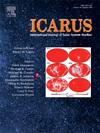暴露于当前火星表面条件下的矿物和含有机物的光谱反射率(0.35-2.50 μm)特性
IF 2.5
2区 物理与天体物理
Q2 ASTRONOMY & ASTROPHYSICS
引用次数: 0
摘要
火星显示了曾经丰富的古代液态地表水的明确证据,推动了对这颗行星的探索,以评估其可居住性和生命的可能性。利用轨道和地面观测对全球火星表面进行了研究,揭示了矿物学的多样性和矿物水化的广泛证据。然而,这些古老的水合矿物究竟是如何受到现代火星寒冷、干燥和荒凉的表面条件的影响,我们仍然知之甚少,这限制了我们对它们原始水合状态的理解。为了更好地研究火星表面矿物学、矿物可探测性和水化状态,我们将27种含水和无水矿物和碳质材料暴露在类似火星的表面条件下66天(~ 500 Pa,二氧化碳,环境温度)。矿物相包括碳酸盐、卤化物、有机物、氧化物、层状硅酸盐(云母和层状硅酸盐)、硫酸盐、硫化物和沸石。它们的选择是基于它们与过去遥感仪器在火星上探测的相关性,以及它们对可居住性和潜在生物特征的重要性。通过密封的蓝宝石玻璃窗,在0.35 ~ 2.50 μm波长范围内对矿物进行周期性的反射光谱表征。部分(但不是全部)水合矿物发生脱水,高岭土、海长石、伊利石、高岭石、蒙脱土、非蒙脱土和蒙脱土的水化带强度降低。我们的数据表明,脱水可能是渐进的,也可能是突然的,但我们的样品都没有完全脱水,因为在显示光谱变化的7个样品中,1.90 μm的吸收带持续存在,但变得更浅。羟基(OH)在1.40 μm区域的吸收特征和2.00-2.50 μm区域的金属-OH吸收带表明,在类火星表面条件下,羟基(OH)除hectorite和trona外,对脱羟基具有很强的抵抗力。这项研究的数据对于通过遥感仪器观测到的火星表面矿物学的可靠识别和解释是不可或缺的。在这项工作中观察到的脱水过程表明,火星上可能发生过类似的过程,这可能会影响基于是否在自然和磨损表面上观察到水化吸收特征的光谱矿物识别。因此,这可能会对全球估计地球上仍然存在的古代矿物结合水的数量产生重大影响。本文章由计算机程序翻译,如有差异,请以英文原文为准。
Spectral reflectance (0.35–2.50 μm) properties of minerals and organic-bearing compounds exposed to current Martian surface conditions
Mars shows unambiguous evidence of once-abundant ancient liquid surface water, driving exploration of the planet to assess habitability and the possibility of life. The global martian surface has been studied using orbital and ground-based observations, revealing mineralogical diversity and widespread evidence of mineral hydration. However, how exactly these ancient, hydrated minerals are affected by the cold, dry, and desolate surface conditions of modern Mars remains poorly understood, which limits our understanding of their original hydration state. To better address Mars surface mineralogy, mineral detectability, and hydration state, we exposed a suite of 27 hydrous and anhydrous minerals and carbonaceous materials to Mars-like surface conditions for 66 days (∼500 Pa, CO2, ambient temperature). The mineral phases included carbonates, halides, organics, oxides, phyllosilicates (micas and phyllosilicates), sulfates, sulfides, and zeolite. They were selected based on their relevance to past detection on Mars by remote sensing instruments and their importance for habitability and potential biosignatures. The minerals were periodically characterized with reflectance spectroscopy over the 0.35 to 2.50 μm wavelength region through a sealed sapphire glass window. Dehydration occurred for some, but not all, hydrated minerals, with decreased intensity of the hydration bands observed for halloysite, hectorite, illite, kaolinite, montmorillonite, nontronite, and trona. Our data indicated that dehydration can be gradual or abrupt, but none of our samples fully dehydrated, as the 1.90 μm absorption band persisted but became shallower in the seven samples that showed spectral changes. Hydroxyl (OH), as evidenced by a 1.40 μm region absorption feature and metal-OH absorption bands in the 2.00–2.50 μm region, was largely resistant to dehydroxylation under Mars-like surface conditions, with the exception of hectorite and trona. Data from this study is integral for the robust identification and interpretation of martian surface mineralogy observed by remote sensing instruments. The dehydration processes observed in this work suggest similar processes on Mars have likely occurred, which can affect spectroscopic mineral identification based on whether or not hydration absorption features are observed on both natural and abraded surfaces. Thus, this can have major implications for global estimates of the amount of ancient, mineral-bound water that is still present on the planet.
求助全文
通过发布文献求助,成功后即可免费获取论文全文。
去求助
来源期刊

Icarus
地学天文-天文与天体物理
CiteScore
6.30
自引率
18.80%
发文量
356
审稿时长
2-4 weeks
期刊介绍:
Icarus is devoted to the publication of original contributions in the field of Solar System studies. Manuscripts reporting the results of new research - observational, experimental, or theoretical - concerning the astronomy, geology, meteorology, physics, chemistry, biology, and other scientific aspects of our Solar System or extrasolar systems are welcome. The journal generally does not publish papers devoted exclusively to the Sun, the Earth, celestial mechanics, meteoritics, or astrophysics. Icarus does not publish papers that provide "improved" versions of Bode''s law, or other numerical relations, without a sound physical basis. Icarus does not publish meeting announcements or general notices. Reviews, historical papers, and manuscripts describing spacecraft instrumentation may be considered, but only with prior approval of the editor. An entire issue of the journal is occasionally devoted to a single subject, usually arising from a conference on the same topic. The language of publication is English. American or British usage is accepted, but not a mixture of these.
 求助内容:
求助内容: 应助结果提醒方式:
应助结果提醒方式:


